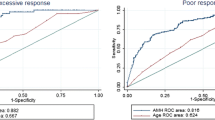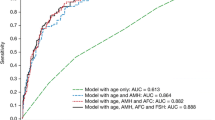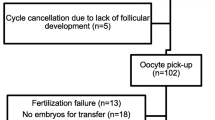Abstract
Purpose: Our purpose was to determine prospectively, usingreceiver-operating characteristic (ROC) analysis, whetherthe ovarian reserve test with hMG could improve thepredictive value of a woman's age and basal levels of folliclestimulating hormone (FSH), E2, and inhibin or anycombination of them regarding ovarian response and pregnancy ratein IVF treatment following pituitary desensitization.
Methods: The hMG test was performed within 3 months ofIVF treatment in 80 women undergoing the first cycle ofIVF and consisted of 2 ampoules of hMG daily for 5 daysstarting on cycle days 2 to 3. Hormone and ultrasoundevaluation was performed on cycle days 2 to 3 and 7 to 8.
Results: The mean age and basal FSH levels weresignificantly higher in the canceled (n = 28) than in the control(n = 52) group, whereas the basal inhibin level wassignificantly higher in the latter. Regarding ovarian response, thecombination FSH plus inhibin had the better diagnosticaccuracy (predictive value of 70%) among basal variables.When post-hMG parameters (alone or in combination) wereanalyzed, E2 alone, with a 77% diagnostic accuracy,emerged as the best predictive variable of cancellation inIVF cycles. When ROC analysis was used, the area underthe ROC curve for E2 post-hMG (diagnostic accuracy of84.5%) was significantly higher than that for the estimatesbased on the combination of basal FSH and inhibin(diagnostic accuracy of 71.3%). However, woman's age was theonly variable independently associated with pregnancy rate.
Conclusions: The predictive power of the hMG test ofovarian reserve is better than that of age and basal hormonevalues (FSH and inhibin) and it is based mainly on the E2response to hMG treatment. However, given that age is theonly predictor of pregnancy and considering the cost anddiscomfort of the hMG test, the usefulness, if any, of the testin predicting IVF performance in the daily clinical settingremains to be established.
Similar content being viewed by others
REFERENCES
Scott RT, Hofmann GE: Prognostic assessment of ovarian reserve. Fertil Steril 1995;63:1-11
Scott RT, Toner JP, Muasher SJ, Oehninger S, Robinson S, Rosenwaks Z: Follicle-stimulating hormone levels on cycle day 3 are predictive of in vitro fertilization outcome. Fertil Steril 1989;51:651-654
Toner JP, Philput CB, Jones GS, Muasher SJ: Basal follicle stimulating hormone level is a better predictor of in vitro fertilization performance than age. Fertil Steril 1991;55:784-791
Cahill DJ, Prosser CJ, Wardle PG, Ford WCL, Hull MGR: Relative influence of serum follicle stimulating hormone, age and other factors on ovarian response to gonadotrophin stimulation. Br J Obstet Gynaecol 1994;101:999-1002
Balasch J, Creus M, Fábregues F, Carmona F, Casamitjana R, Ascaso C, Vanrell JA: Inhibin, follicle-stimulating hormone, and age as predictors of ovarian response in in vitro fertilization cycles stimulated with gonadotropin-releasing hormone agonist-gonadotropin treatment. Am J Obstet Gynecol 1996; 175:1226-1230
Farhi J, Homburg R, Ferber A, Orvieto R, Ben Rafael Z: Non-response to ovarian stimulation in normogonadotrophic, normogonadal women: A clinical sign of impending onset of ovarian failure pre-empting the rise in basal follicle stimulating hormone levels. Hum Reprod 1997;12:241-243
Kim MR: Screening for ovarian reserve. Assist Reprod Rev 1998;8:17-22
McDonough PG, Mahesh VB, Byrd JR: The diagnostic use of gonadotrogonadotropins. Fertil Steril 1970;21:126-133
Netter A, Millet D, Salomon-Bernard Y: Ovarian stimulation tests using human menopausal gonadotropin (HMG). J Reprod Fertil 1970;21:313-317
Hanley JA, McNeil BJ: The meaning and use of the area under receiving operating characteristic (ROC) curve. Radiology 1982;143:29-36
Zweig MH, Campbell G: Receiver-operating characteristic (ROC) plots: A fundamental evaluation tool in clinical medicine. Clin Chem 1993;39:561-577
Balasch J, Fábregues F, Creus M, Moreno V, Puerto B, Peñarrubia J, Carmona F, Vanrell JA: Pure and highly purified follicle-stimulating hormone alone or in combination with human menopausal gonadotrophin for ovarian stimulation after pituitary suppression in in-vitro fertilization. Hum Reprod 1996;11:2400-2404
Fábregues F, Balasch J, Creus M, Cívico S, Carmona F, Puerto B, Vanrell JA: Long-term down-regulation does not improve pregnancy rates in an in vitro fertilization program. Fertil Steril 1998;70:46-51
Burger HG, Groome NP, Robertson DM: Both inhibin A and B respond to exogenous follicle-stimulating hormone in the follicular phase of the human menstrual cycle. J Clin Endocrinol Metab 1998;83:4167-4169
Balasch J, Jové IC, Moreno V, Civico S, Puerto B, Vanrell JA: The comparison of two gonadotropin-releasing hormone agonists in an in vitro fertilization program. Fertil Steril 1992;58:991-994
de Mouzon J, Lancaster P, and the International Working Group for Registers on Assisted Reproduction: World collaborative report on in vitro fertilization. Preliminary data for 1995. J Assist Reprod Genet 1997;14:251S-265S
Schattman GL, Davis OK, Rosenwaks Z: Patient selection and screening for assisted reproductive technology. Infertil Reprod Med Clin North Am 1993;4:619-641
Groome NP, Illingworth PJ, O'Brien M, Pai R, Rodger FE, Mather J, McNeilly AS: Measurement of dimeric inhibin B throughout the menstrual cycle. J Clin Endocrinol Metab 1996;81:1401-1405
Seifer DB, Lambert-Messerlian G, Hogan JW, Gardiner AC, Blazar AS, Berk CA: Day 3 serum inhibin-B is predictive of assisted reproductive technologies outcome. Fertil Steril 1997;67:110-114
Galtier-Dereure F, De Bouard V, Picot MC, Vergnes C, Humeau C, Bringer J, Hedon B: Ovarian reserve test with the gonadotrophin-releasing hormone agonist buserelin: Correlation with in-vitro fertilization outcome. Hum Reprod 1996;11:1393-1398
Roest J, van Heusden AM, Mous H, Zeilmaker GH, Verhoeff A: The ovarian response as a predictor for successful in vitro fertilization treatment after the age of 40 years. Fertil Steril 1996;66:969-973
Franchin R, de Ziegler D, Olivennes F, Taieb J, Dzik A, Frydman R: Exogenous follicle stimulating hormone ovarian reserve test (EFORT): A simple and reliable screening test for detecting “poor responders” in in-vitro fertilization. Hum Reprod 1994;9:1607-1611
Sharif K, Elgendy M, Lashen H, Afnan M: Age and basal follicle stimulating hormone as predictors of in vitro fertilisation outcome. Br J Obstet Gynaecol 1998;105:107-112
Author information
Authors and Affiliations
Rights and permissions
About this article
Cite this article
Fábregues, F., Balasch, J., Creus, M. et al. Ovarian Reserve Test with Human Menopausal Gonadotropin as a Predictor of In Vitro Fertilization Outcome. J Assist Reprod Genet 17, 13–19 (2000). https://doi.org/10.1023/A:1009441812247
Issue Date:
DOI: https://doi.org/10.1023/A:1009441812247




